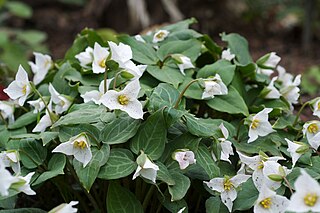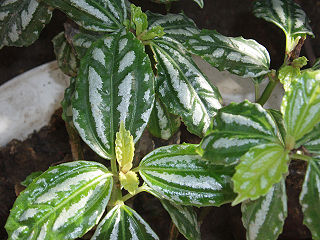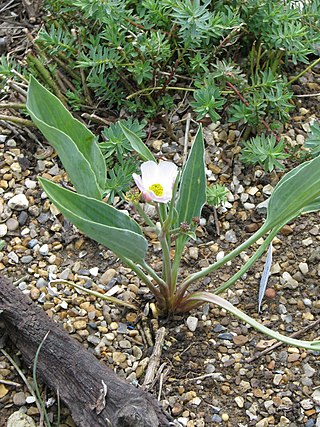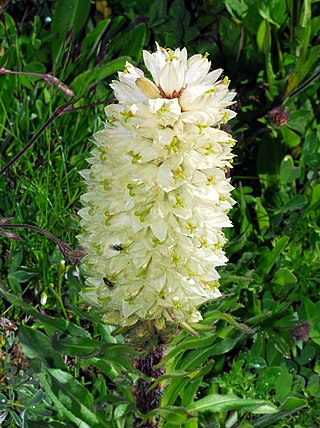
Hyacinthus orientalis, the common hyacinth, garden hyacinth or Dutch hyacinth, is a species of flowering plant in the family Asparagaceae, subfamily Scilloideae, native to southwestern Asia, southern and central Turkey, northwestern Syria, Lebanon and northern Israel. It was introduced to Europe in the 16th century. It is widely cultivated everywhere in the temperate world for its strongly fragrant flowers which appear exceptionally early in the season, and frequently forced to flower at Christmas time.

Abutilon pictum, syn. Abutilon striatum (disputed), is a species of flowering plant in the family Malvaceae. It is native to southern Brazil, Argentina, Paraguay and Uruguay. The plant has become naturalised in Central America, and is used in horticulture. Common names include redvein abutilon, red vein Indian mallow, redvein flowering maple, Chinese-lantern and red vein Chinese lanterns.

Pseudotrillium is a monotypic genus of flowering plant in the family Melanthiaceae. Its sole species, Pseudotrillium rivale, is commonly known as the brook wakerobin. It is endemic to the Siskiyou Mountains of southern Oregon and northern California. The Latin specific epithet rivale means “growing by streams”, with reference to a preferred habitat.

Primula elatior, the oxlip, is a species of flowering plant in the family Primulaceae, native to nutrient-poor and calcium-rich damp woods and meadows throughout Europe, with northern borders in Denmark and southern parts of Sweden, eastwards to the Altai Mountains and on the Kola Peninsula in Russia, and westwards in the British Isles.

Ornithogalum dubium, common names sun star, star of Bethlehem or yellow chincherinchee, is a species of flowering plant in the family Asparagaceae, subfamily Scilloideae. It is a South African endemic.

Crambe cordifolia, the greater sea-kale, colewort or heartleaf crambe, is a species of flowering plant in the family Brassicaceae, native to the Caucasus. It has gained the Royal Horticultural Society's Award of Garden Merit.

Genista tinctoria, the dyer's greenweed or dyer's broom, is a species of flowering plant in the family Fabaceae. Its other common names include dyer's whin, waxen woad and waxen wood. The Latin specific epithet tinctoria means "used as a dye".

Hylotelephium spectabile is a species of flowering plant in the stonecrop family Crassulaceae, native to China and Korea. Its common names include showy stonecrop, iceplant, and butterfly stonecrop.

Stephanotis floribunda syn. S. jasminoides, the Madagascar jasmine, waxflower, Hawaiian wedding flower, or bridal wreath is a species of flowering plant in the family Apocynaceae, native to Madagascar. It is a twining, sparsely branched liana that can measure up to 6 m in length.

Pilea cadierei is a species of flowering plant in the nettle family Urticaceae. The species is endemic to the southern Chinese provinces of Guizhou and Yunnan, as well as Vietnam. The specific epithet cadierei refers to the 20th-century botanist R.P. Cadière. P. cadierei has earned the Royal Horticultural Society's Award of Garden Merit for its hardiness and reliability as a houseplant. In warmer countries, usually within USDA zones 8-12, the plant may be grown outside year-round as a perennial, either in-ground or contained, and pruned about 50% during the autumn.

Albuca bracteata, is known by the common names pregnant onion, false sea onion, and sea-onion. It is a species of bulbous flowering plant in the family Asparagaceae. Its flowering stems can reach a height of 90 cm and can carry up to 100 greenish white flowers.

Ornithogalum nutans, known as drooping star-of-Bethlehem, is a species of flowering plant in the family Asparagaceae, native to Europe and South West Asia. It is a bulbous perennial growing to 20–60 cm (8–24 in) tall by 5 cm (2 in) wide, with strap-shaped leaves and green striped, pendent grey-white flowers in spring. It is cultivated, and has naturalized, outside its native range, for example in North America. It has become extremely invasive along the Chesapeake and Ohio Canal in Maryland. At least in North America, it is not as common as Ornithogalum umbellatum.

Hylotelephium cauticola, the cliff stonecrop, syn. Sedum cauticola, is a species of flowering plant in the family Crassulaceae, native to Hokkaido, Japan. Growing to 8 cm (3 in) tall by 30 cm (12 in) wide, it is a carpet-forming succulent perennial with trailing stems of pink-tinged grey-green round leaves, and purplish pink star-shaped flowers in autumn.

Salvia patens, the gentian sage or spreading sage, is a species of flowering plant in the sage family Lamiaceae that is native to a wide area of central Mexico. This herbaceous perennial was introduced into horticulture in 1838 and popularized a hundred years later by the Irish gardener and botanist William Robinson (1838-1935).

Lewisia cotyledon is a species of flowering plant in the family Montiaceae known by the common names Siskiyou lewisia and cliff maids. It is native to southern Oregon and northern California, where it grows in rocky subalpine mountain habitat.

Cyclamen hederifolium, the ivy-leaved cyclamen or sowbread, is a species of flowering plant in the family Primulaceae. This widespread cyclamen species is widely cultivated and among the most hardy and vigorous in oceanic climates. It is native to woodland, shrubland, and rocky areas in the Mediterranean region from southern France to western Turkey and on Mediterranean islands, and naturalized farther north in Europe and in the Pacific Northwest.

Veltheimia capensis is one of two species of flowering plants belonging to the genus Veltheimia, of the family Asparagaceae. It is a tender bulbous perennial reaching a height of 46 cm (18 in), with flowers varying in color from white with red spots to pink with green or red markings.

Ranunculus calandrinioides, the high alpine buttercup, is a species of flowering plant in the family Ranunculaceae, native to the Atlas Mountains of North Africa. Growing to 20 cm (8 in) tall by 15 cm (6 in) broad, it is an herbaceous perennial with broad, grey-green leaves which die down in summer, and white flowers, often tinged with pink, in winter and spring. It is one of the earliest buttercups to flower.

Cyrtanthus falcatus, the falcate fire lily, is a species of flowering plant in the amaryllis family Amaryllidaceae from the Natal region of South Africa. A bulbous perennial growing to 30 cm (12 in), it has glossy, strap-shaped leaves and erect burgundy-coloured stems. These bear umbels of 8-10 narrowly-flared, pendulous tubular flowers in shades of red, green and cream in spring and summer. The umbels are bent over in a curious crook or sickle shape. The plant goes dormant in winter. The bulb, shaped like a bowling pin, rests with its neck above the soil line.

Campanula thyrsoides is a flowering plant belonging to the family Campanulaceae.






















